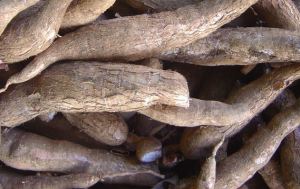Mary Mwendwa
December 09, 2012
Large dry fields of farms, dry water wells, donkey carrying water jerry cans, women and children walking down the valleys with jerry cans and huge baobab trees dotting the landscape are what lead me to Kanzilu village in Mutomo, Eastern Kenya.
I am on a mission to meet Mutunga Mbai, a father of seven in his mid-fifties engaged in cassava farming to cope with climate change.

I am in a group of journalists and all we see is the dryness in Mutunga’s farm, an indicator that it has not rained in a longtime. We are welcomed humbly by the family and set for us is tea and boiled cassavas.
His loyal cat plays around the table starring at us as Mutunga picks a piece of cassava and gives him. ”This is what my family feeds on, we have no other food, every time I try and plant maize, the crop fails due to lack of rain, ” he tells us.
Mutungu is one among many farmers in Mutomo, who have turned to cassava farming as a result of severe climatic conditions that put their lives to risk. A recent study found that cassava, a traditional root crop that is a staple for millions of Africans, could help farmers deal with climate change.
“People here were so used to planting maize, in the recent past, crops like maize have failed and therefore they have turned to drought tolerant crops which are also known as orphaned crops such as sorghum, millet, cowpeas and cassava,” says Benedict Mathitu, a Divisional Crops officer, Mutumo Division.
He adds that Mutomo receives an average rainfall of 300 mm – 600 mm annually. This makes it difficult for farmers to invest in planting crops that are not drought tolerant.
“The last time I had a good harvest was in 2003, since then I have never harvest any other crop apart from cassava,” says Mutunga. He is also a leader of several self-help groups that get a lot of support from the Ministry of Agriculture through extension services. They normally receive trainings and cassava seeds.
One of the groups that he works closely with is Wikwatyo wa Kandae meaning ‘Hope of Kandae’ self Help Group. The group is involved in cassava farming.
Musenya Joseph, one of the group members says cassava farming has so many advantages compared to other crops like maize.
Being a drought resistant crop, they don’t have to worry about the rains. They also use it as food for their families. The plant’s leaves are food for their livestock too.
“We have a serious shortage of water here in Mutomo, most of the wells are dry now, we walk for many kilometers to fetch water that is not very clean and treated,” Anastancia Musenya tells me.
She shyly adds that cassava is a delicacy that they can’t miss in their homestead. “It has a special function of boosting men’s vitality,” she adds.

However, there are challenges of diseases and pests that attach their growing cassava. There is also the issue of cyanide poisoning which many farmers have knowledge about.
Dr. Cyrus Githunguri, an agronomist / crop physiologist in charge of Kari Katumani, has done several studies on cassava for over twenty years. He cites cyanite not as a big threat to cassava consumers.
He says human body has a natural way of fighting cyanide but also advises people to eat well cooked cassava.
Cassava farming is not only helping people here in fighting food security but also reducing the economic burden of farmers and Dr. Githunguri wants farmers to take this advantage to fight poverty in their homesteads.
He tips them of markets in cities such as Nairobi, Eldoret and outside Kenya only if they get the cassava in large quantities.
Mutomo climate is good for drying cassava chips which is an advantage to the farmers in the region.
Dr.Githunguri further adds that there is a need for farmers to use improved seed varieties from KARI (Kenya Agricultural Research Institute) noting that these don’t have disease strains and take only 8 months to one year to mature.
The common cassava diseases in the region include cassava mosaic and brown stalk which is commonly found in the coastal region of Kenya.
“People in Mutomo have depended on food relief for a long time, its high time we found our own sustainable ways of survival, ” Martha Mwangi, who works with over forty farmer groups in the region,” says.
She believes that cassava farming has greatly improved the livelihoods of many Mutomo families.
The groups she works with own a bakery which makes bread mixed with wheat and cassava flour. Other delicacies made from cassava are cakes, chapatti, chips and crisps which are sold in the local market.
With agriculture accounting for 29% of Gross Domestic Product (GDP) in developing countries and employment for 65% of population, communities living in Arid and semi-Arid Lands have no choice but to adopt to improve on their food security by farming the climate smart way.
